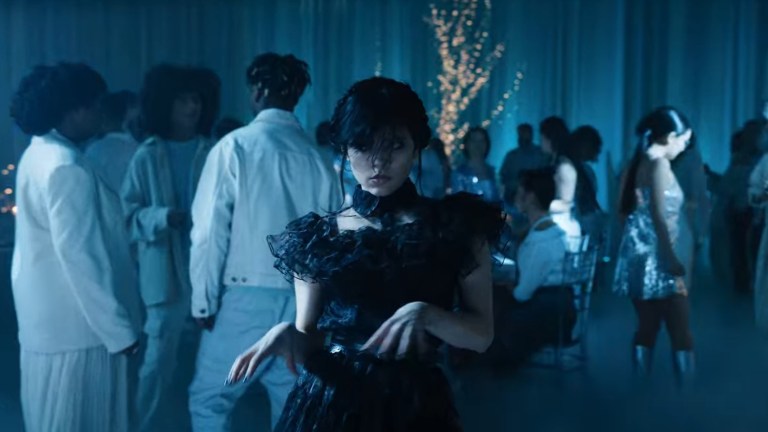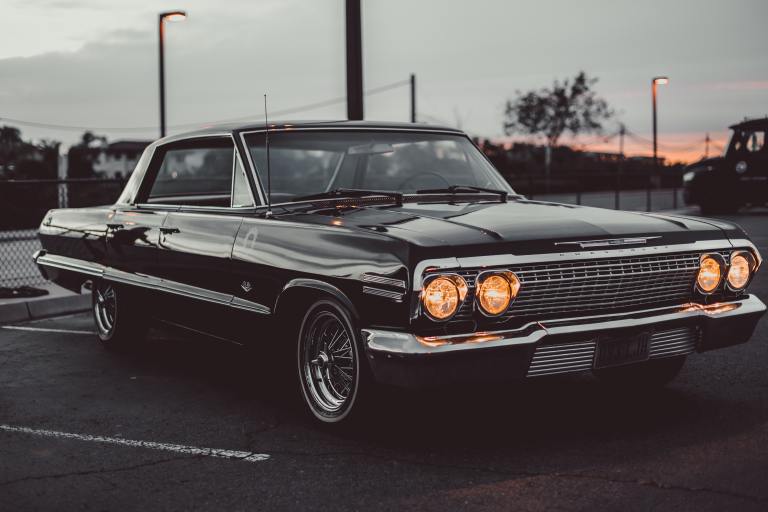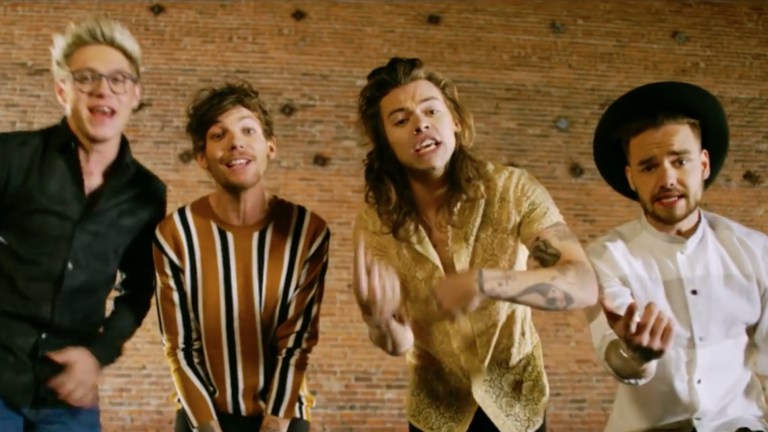Who Is My Bloody Valentine? Why Do They Matter?
It is no longer a question of if you should listen to the new My Bloody Valentine album. It's a question of what you will say about it, and whose side you'll be on.

Music rarely exists in a vacuum. Bob Dylan had Woody Guthrie. Radiohead have Aphex Twin. The Lumineers have, er, Mumford & Sons. When Ol’ Dirty Bastard is introduced on Wu-Tang Clan’s Enter the Wu-Tang as having “no father to his style,” the paternity test is Busta Rhymes’ verse on A Tribe Called Quest’s “Scenario.” It’s a richly potential-filled thing, to know your favorite bands are part of a musical tradition descended through dozens of singers and songs waiting to be heard. But there are exceptions. My Bloody Valentine’s Loveless wasn’t born in a vacuum: it is the vacuum, all relentless noise and orbital gravity. There’s never been music quite like it, until Saturday night’s miracle birth.
To say the pregnancy resulting in m b v was extended would be the understatement of the quarter-century. Loveless came out on Creation Records in 1991; it is now old enough to be done with college and buried in debt, a step the band got out of the way in advance. I was busy struggling through first grade that year. A frenemy had turned recess into Lord of the Flies on me and I took solace in Darkwing Duck and The New Adventures of Winnie-the-Pooh, if I woke up early enough to catch them on TV. I was into the Beatles before I quit on music for Spider-Man and dreams of a career in comic art until high school.

I bought Loveless at an indie record store during senior year in late 2002, along with the Pixies’ Doolittle and Sonic Youth’s Daydream Nation. They were among the last CDs I picked up before going to college and buying an iPod; I think they were on sale. Having gone through most of the previous decade of underground music with funds from a part-time job, the guidance of Pitchfork lists, and the half-dozen hipsters at school who’d tolerated my very public, very obnoxious Year of Indie Discovery a couple semesters earlier, I was ready at last for the classics. It was clear from SPIN mentions, message board adoration and a forgotten famous-band interview that talked a lot about staying up past my bedtime, smoking pot and playing it on loop that Loveless was an essential.
Like Kid A before it, it didn’t change my life, stopping just short of whatever chemical triggers and cerebral stimuli squeezed albums such as OK Computer and Elliott Smith’s Roman Candle directly to the pleasure centers of my brain. Maybe I was too dizzy with other discoveries to feel the entire high, but I still appreciated the rush. The songs I liked the most sounded like the good parts of a Godzilla movie; while the jocks were bumping Nelly and Ludacris, we’d let it breathe fire out the windows as we left the school parking lot for In-N-Out. Not so many months later, at a screening of Sofia Coppola’s Lost in Translation, I found a different visual aesthetic to match to the band’s less volcanic side. A neon Tokyo, softened by rose-tinted lenses and Scarlett Johansson; yes, this was dreamland, the kind of place you reach past bedtimes, under the influence, with “Sometimes” churning just out of reach. Kevin Shields, the band’s mad genius, had soundtracked the film in a rare exit from the lab, offering a pocket-sized Loveless non-sequel: his new songs, including the standout “City Girl,” were familiar without attempting the band’s sonic immensity. He was holding something back, if only to keep from stomping the city to pieces.
That’s my story. You have yours. Listeners don’t exist in a vacuum any more than music does — we all have our own ways of coming to the albums that fill up our lives, un-break our hearts, make us who we are. You may have noticed it’s hard to squeeze that into a two-paragraph blog write-up. Beyond the personal, music criticism tends to frown upon true believers, fans who can name a band’s b-sides alphabetically: they know too much. How can they pass judgment for the masses? Especially not when next week’s releases are already queued up, waiting anxiously to be skipped to, skimmed, processed and perhaps, deleted. But an album — an occasion — like this demands to be positioned within the band’s galaxy-sized mythology: the enduring, primordial power of Loveless; the financial destruction it wreaked on Creation; the band’s own years of probable creative bankruptcy; mystic, erratic frontman Kevin Shields’ unknowable psychological stability; the surprising Elmer’s Glue of the band’s half-decade strong reunion. If you believe in rock bands as gods, Shields hurling lightning bolts of noise from Mount Pedalympus, this is the story you want to sit by the fire and hear.
Not everyone, of course, is a true believer. When the Arcade Fire won the Grammy for Album of the Year in 2010, Paul Tao — co-runner of L.A.’s IAMSOUND Records, a former music blogger, and a guy I played Magic: The Gathering with over the weekend — started a Tumblr blog capturing the air horns of disbelief that blasted across the Internet immediately after. From even a casually hipster-ish perspective, it was a ridiculous situation: the band had arguably been the biggest breakthrough indie rock act of the previous decade, landing Rolling Stone covers and radio airplay on stations including L.A.’s KROQ, where “Neighborhood #1 (Tunnels)” logged plays between greying Green Day and Foo Fighters hits. The group’s sold hundreds of thousands of albums and bowed at the top of the Billboard charts. For anyone paying a modicum of attention to modern-day music, one might think that not knowing the Arcade Fire would mean not knowing anything. And yet. What Who Is Arcade Fire? revealed was the cultural firewall between Pitchfork readers and the likes of the Rihanna Navy, swimming at opposite ends of apparently Pacific-sized social networks, with the horizon too far off to make out.
Who Is Arcade Fire? was started as a joke, but not a mean one. But like any influential band, it set off a chain of imitators belligerently missing the point. This January, the Stone Roses’ announcement atop the Coachella bill baffled teenagers and twenty-somethings who hadn’t spent 1989 being a melancholy 17-year-old Londoner. In Southern California, the band’s familiarity level quite reasonably lands between “cold weather” and “absolute zero.” Of course the phenomenon couldn’t go undocumented, and another Tumblr blog arose, this time with a chorus of finger-pointing Twitter cranks — who, God forbid, should take the time to realize not everyone shares their record-buying chronology. Kids These Days weren’t helping themselves, either, offering up defiant tweets about not caring who the Stone Roses are. At a time when we’re supposed to be the most liberal generation ever, perhaps musical ignorance is the last kind we’re allowed to be proud of.

So what kind of event is m b v? What kind of world has the child of Loveless entered? My Bloody Valentine, thank Creation, are not the Stone Roses. Loveless is one of a handful of universally beloved albums believed to have truly changed rock music. Despite the best efforts of several generations of bands, nothing else has ever sounded quite like it. You could be six years old in 1991, as I was, and find your way to it. During Saturday night’s fever-pitch online release, the dominant reaction — after the frustration of a ‘90s-reminscent crashing server — seemed to be one of awe. Joy. Respect. The “Who is MBV” tweets were there, if you searched, but nobody started a fucking Tumblr. But anxiousness rippled across the true believers. Who would be first to render judgment on the work of the gods? As the album interminably made its way from cyberspace to my MacBook Air, Beach House — a band whose sense of space and texture owes much to the group — tweeted this: “Don’t read what anyone is writing/going to write, just listen to the new #mbv record without some idiot clouding your thoughts.”
We’re not all idiots. But the question arises: in 2013, why review anything from behind the snakeskin of objectivity and authority? It’s not like anyone’s struggling to make judgments on new music: Pitchfork, the Internet’s most powerful critical force, recently joined goliath competitor/colleague NPR in offering a full plate of weekly advance album streams, the better for forming opinions before the review. Many artists, particularly electronic ones, release their entire output through on-demand streaming sites such as SoundCloud, worrying about listeners first and money second. Even old-school major label acts such as Usher and R. Kelly drop their new singles there. Cloud services such as Spotify and Rdio can be used for free, to an extent; and in reality, more people listen to Justin Bieber on YouTube on a big day than use everything else combined. On the Internet, if not elsewhere, the music industry has bypassed its own gatekeepers and surrendered itself to the public.
About 15 years ago and right up until then, the dividing line between critics and everyone else was 1) the ability to hear music before its release date 2) free records, and many of them. Unless you worked at a record store, being a dedicated music fan meant spending your extra cash wisely. Critics could help with that; it’s why a site such as Rotten Tomatoes still makes a considerable impact on film, which hasn’t quite become the financial disaster of the music business. With music, as many records as a Pitchfork review might sell, those paradigms no longer exist. An old joke went, everyone’s a critic and the rest are DJs. It was funny before it came true. It is no longer a question of if you should listen to the new My Bloody Valentine album. It’s a question of what you will say about it, and whose side you’ll be on.
That’s the cynical view. I think we can do better — critics can draw connections, illuminate cultural significance, bridge the gap between art and intent. Context and shared knowledge, the kind many fans have already, can make listening richer and deeper. But first, let’s consider exactly how many people might care to go there. Because love is immeasurable and My Bloody Valentine is unlikely to report to SoundScan, here are some statistics to Nate Silver over. After five days on one popular private music torrent site, 11,230 copies of the album had been downloaded in various formats, and that’s not counting the thousands from the band’s official 320kpbs MP3 release — which was dumped from the site for appearing to be a transcode, a torrent-nerd term for MP3s that have gone through an unnecessary, quality chopping second conversion. Your tolerance for Napster-era 128kpbs MP3s depending, transcodes, this one included, sound obvious and bad. 11,230 copies, were it a sales figure, isn’t bad for an indie act: Taylor Swift, at No. 10 on the Billboard chart during MBV release week, moved 29,000 units, and over an extra two days, too. The popular public site The Pirate Bay doesn’t keep download records, those jerks, but we can add another 1,300 based on sharing users at the time of this writing. Guessing conservatively, a number closer to 20,000 illegal downloads is probably a safer bet.
In our post-pirate era, normal (read: smart) people have abandoned their files for YouTube, of course, where MBV’s official channel has done astoundingly well (and people care a hell of a lot less about file quality). First track “She Found Now” appears to be the album’s big hit, with over 512,395 views; outside of “Nothing Is,” the album’s most abrasive track, all are over 80,000 or deep into the 100s. The album is not on Spotify or Rdio or iTunes or Amazon; the top songs on Spotify at this pivotal moment in music history are “Thrift Shop” by Macklemore and Ryan Lewis and the Lumineers’ “Ho Hey,” a rustic track so tenuously musical it makes Bon Iver look like Beethoven. I’m glad people are listening to My Bloody Valentine this week, however many there are.
It wasn’t long ago that the experience of listening to music was at least partially standardized, with the CD providing common ground between car stereos and Walkmen. iTunes files offer that still, but with the band’s buffet of options, the potential My Bloody Valentine experience ranges from 192kpbs YouTube files played from laptop speakers to lossless 24-bit studio-level audio channeled through $1000 headphones via solid-gold wiring from vintage analog receivers. When I say I’ve heard the new My Bloody Valentine album, I don’t know if it’s possible to define that experience in a way we can share.
The absolutely crucial thing about m b v is that we come as close as possible to getting there. This album, no argument required, is one of the most sonically intricate, richly textured recordings ever engineered. It’s so easy to forget in the MP3 era, but in this case more than most, the better this album sounds, the better this album is. Start by skipping the official 320kpbs download. It sounds flat and sad, a three-color rendering of the album’s full palette. Do not, under any circumstances, listen to it on YouTube — you might as well look at iPhone photos of the Grand Canyon. You need to go there. Download one of the band’s lossless options and make your own MP3 rip, if you must. I’m listening now to a fan-ripped V0 rendering, the quality of which allows for a breathtaking dynamic range. On Sony MDR-V6 headphones, which run about $100 on Amazon, I can hear the volume of “nothing is” rise with horror-movie patience, until the hammering guitars feel millimeters from bloodying my eardrums. The pedal-warped guitars of “if i am” feel like spinning. The celestial keyboards of “is this and yes” sway back and forth like doors to the heavens opening and closing, the drums below them the sound of my own heartbeat. “in another way” could be a flaming starship, leaving debris and shrapnel in its wake. I haven’t even listened to this on drugs yet.
This music, at the right volume, in high enough quality (an issue so bafflingly not aided by the band’s MP3 purchasing option), on the right headphones, is so viscerally present that you can nearly touch it. The problem with poor quality is the compression: the sound waves flatten out, pressing inside your ears like blocks of stupidly loud cardboard. m b v sounds like the Rocky Mountains, majestic and strong. Flat, volume-centric engineering is one reason why live music can trigger our feelings so much more readily — because it still sounds like music. Please, please give that privilege to this album.
If you do, you’ll find a gorgeous but difficult record, an album that blunts Loveless’ pop instincts in favor of more subtly constructed, texturally staggering songs. I listened to this album first on my laptop speakers, in the bathroom, while checking Twitter: the worst-case scenario. It sounded powerful but slight, the guitar lines and melodies slow and repetitive despite the obvious sonic promise. The first headphones play was like opening a treasure chest. I’d missed everything. No, these aren’t quite pop songs — the melodies often sustain tension instead of resolving it in the climactic riffing of “Loomer” or the satisfying vocal turns of “Come in Alone.” Instead, the songs come like icebergs, slowly and heavily, the visible peak a glimmering distraction as the real action happens deep underneath. Guitars collapse into each other like tectonic plates, vocals drift and float like damp ghosts, drums do an elephantine dance. Don’t come looking for choruses — just escalation. The band’s biggest concession is “New You,” a song that looks back to the group’s psych-pop beginnings with a bum-bum fuzz bass that’s so simple and upfront, it’s funny. Next to “nothing is,” it sounds like Paul McCartney.
Maybe, all things considered, we did need more love. m b v has inspired a rare degree of civility in the dialogues of its opening week, the shock of its existence rattling the backlash and name-calling into a temporary coma and leaving room for actual ideas. It’s too soon to say if the album’s helped us turn a collective corner past the binary hate-it-or-love-it wars that rage endlessly all the way from indie snobs down to 12-year-old Lady Gaga fans. But if any record will, it’s this one. Like Loveless before it, m b v paints with colors other musicians can’t see, turning to spectrums thought impossible to reach. Many have sought to copy the style, while others have attempted the scale: most of the Smashing Pumpkins’ catalog, not to mention Andrew WK’s infinitely multi-tracked I Get Wet, could be considered attempts to build higher towers of guitar noise. But they look like pancakes compared with this record’s textural complexity. I never felt the absence of My Bloody Valentine in my life before this, but they’ve been gone for a very long time. I’m just happy I know who they are. ![]()




